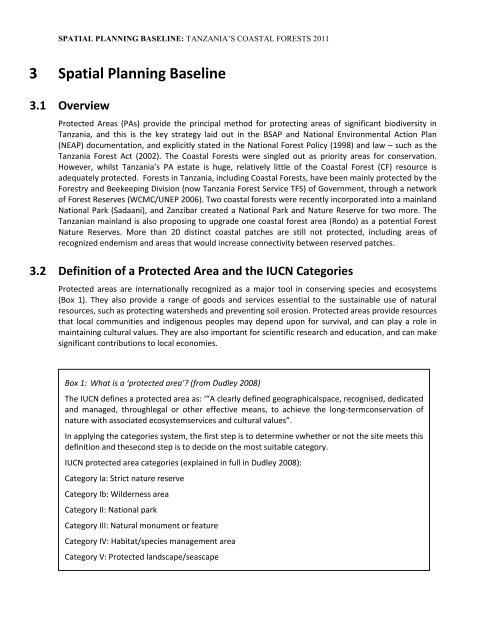Neil D. Burgess, Paul Harrison, Peter Sumbi, James Laizer, Adam ...
Neil D. Burgess, Paul Harrison, Peter Sumbi, James Laizer, Adam ...
Neil D. Burgess, Paul Harrison, Peter Sumbi, James Laizer, Adam ...
Create successful ePaper yourself
Turn your PDF publications into a flip-book with our unique Google optimized e-Paper software.
SPATIAL PLANNING BASELINE: TANZANIA’S COASTAL FORESTS 2011<br />
3 Spatial Planning Baseline<br />
3.1 Overview<br />
Protected Areas (PAs) provide the principal method for protecting areas of significant biodiversity in<br />
Tanzania, and this is the key strategy laid out in the BSAP and National Environmental Action Plan<br />
(NEAP) documentation, and explicitly stated in the National Forest Policy (1998) and law – such as the<br />
Tanzania Forest Act (2002). The Coastal Forests were singled out as priority areas for conservation.<br />
However, whilst Tanzania’s PA estate is huge, relatively little of the Coastal Forest (CF) resource is<br />
adequately protected. Forests in Tanzania, including Coastal Forests, have been mainly protected by the<br />
Forestry and Beekeeping Division (now Tanzania Forest Service TFS) of Government, through a network<br />
of Forest Reserves (WCMC/UNEP 2006). Two coastal forests were recently incorporated into a mainland<br />
National Park (Sadaani), and Zanzibar created a National Park and Nature Reserve for two more. The<br />
Tanzanian mainland is also proposing to upgrade one coastal forest area (Rondo) as a potential Forest<br />
Nature Reserves. More than 20 distinct coastal patches are still not protected, including areas of<br />
recognized endemism and areas that would increase connectivity between reserved patches.<br />
3.2 Definition of a Protected Area and the IUCN Categories<br />
Protected areas are internationally recognized as a major tool in conserving species and ecosystems<br />
(Box 1). They also provide a range of goods and services essential to the sustainable use of natural<br />
resources, such as protecting watersheds and preventing soil erosion. Protected areas provide resources<br />
that local communities and indigenous peoples may depend upon for survival, and can play a role in<br />
maintaining cultural values. They are also important for scientific research and education, and can make<br />
significant contributions to local economies.<br />
Box 1: What is a ‘protected area’? (from Dudley 2008)<br />
The IUCN defines a protected area as: ‘“A clearly defined geographicalspace, recognised, dedicated<br />
and managed, throughlegal or other effective means, to achieve the long-termconservation of<br />
nature with associated ecosystemservices and cultural values”.<br />
In applying the categories system, the first step is to determine vwhether or not the site meets this<br />
definition and thesecond step is to decide on the most suitable category.<br />
IUCN protected area categories (explained in full in Dudley 2008):<br />
Category Ia: Strict nature reserve<br />
Category Ib: Wilderness area<br />
Category II: National park<br />
Category III: Natural monument or feature<br />
Category IV: Habitat/species management area<br />
Category V: Protected landscape/seascape<br />
Category VI: Protected area with sustainable use of natural resources

















